#Boris Petrova
Explore tagged Tumblr posts
Text
Boris Petrova’s Presidency

1996: The influential Petrova family, with roots in both America and the Soviet Union, rises to prominence. Boris Petrova, a charismatic, but no-nonsense politician, wins the presidential election, promising stability and a new era of prosperity under a socialist framework.
“Today, we embrace a new dawn where the power of the people transcends the chains of capitalism, forging an America where collective effort and shared prosperity will guide us to a brighter, socialist future.”
– Boris Petrova, from his first inauguration speech.
Boris Petrova was a former US diplomat who served in Soviet Russia. He was born in the United States, his father a Russian diplomat living in the US. Boris moved back to the U.S. in the late 1980s and quickly rose through the political ranks due to his charisma and connections. He became President in 1996, leading the country with a vision of socialist transformation.

During Boris Petrova's presidency, the United States underwent significant transformations. His administration dealt with major natural disasters, initiated substantial military reforms, and navigated complex international relations. Domestically, his policies focused on centralizing economic control, expanding social welfare, and promoting cultural and educational reforms aligned with socialist ideals. These efforts aimed to stabilize the nation, improve living standards, and align the U.S. with its new identity as a socialist state under the influence of Soviet principles.
1997: Introduction of the "People’s Welfare Act" which expands social welfare programs, including universal healthcare and free education, funded by the nationalized industries.
1998: A massive earthquake strikes California, causing widespread devastation in cities like Los Angeles and San Francisco. Boris Petrova’s administration mobilizes federal resources for reconstruction and introduces the "National Disaster Response and Recovery Act" centralizing disaster management under federal control.
1999: Tensions escalate with NATO over Eastern Europe. Boris Petrova adopts a stance of military readiness, increasing defense spending and modernizing the military to ensure the U.S. remains a formidable force despite Soviet influence.
In that same year, the establishment of the "National Economic Planning Act" which sets up a centralized economic planning committee to oversee industrial production, agricultural output, and technological development, ensuring alignment with socialist goals.
2000: Boris Petrova consolidates power, aligning the U.S. more closely with Soviet principles. Nationalization of key industries and increased state control over media and education ensue.
Hurricane Allison wreaks havoc along the Gulf Coast, leading to significant flooding in Texas and Louisiana. The Petrova administration deploys federal troops for rescue and recovery operations and establishes a comprehensive flood defense program.
2001: The "Great American Military Reform" is enacted, integrating military forces into a single, streamlined command structure to improve efficiency and control.
In the same year, the U.S. and Soviet Union sign the "New Harmony Treaty" aimed at reducing nuclear arsenals and promoting peace. This treaty marks a significant thaw in U.S.-Soviet relations and establishes joint space exploration initiatives.
2002: Launch of the "Five-Year Plan for Technological Advancement" focusing on state-funded research and development in technology and infrastructure.
This went hand in hand with the Implementation of the "Unified Education System" standardizing curricula across the nation to emphasize socialist principles, Soviet history, and collective values alongside American history and civic responsibility.
2003: Boris Petrova plays a key role in the formation of the "Global Socialist Coalition" a political and economic alliance with other socialist-leaning countries, aimed at counterbalancing the influence of NATO and capitalist nations.
2004: Boris Petrova's Son Elias Petrova, becomes Vice President, signaling the beginning of a political dynasty. The Petrova family manipulates elections and uses their influence to maintain control through the media, educational institutions and financial compensation.
Elias is Boris's son, who followed in his footsteps. He becomes vice-president. Educated in both Soviet and American institutions, Elias was known for his strategic mind and political acumen. As President, he continued his father's legacy of centralization and state control, accelerating both.
2005: Boris pushes for and ultimately begins a “centralization” of the states. Borders are altered to create four districts to help consolidate power and reduce citizen autonomy.
The Atlantic District:
- Consolidated into a single administrative unit, the Atlantic District, this region would focus on education, technology, and maritime industries.
- Major cities like Boston and Hartford would serve as distribution centers for this district
- [Former] New York still acts as the entertainment capital of the country. However, it is a far cry from what it used to be in the days of the Republic.
The Great Plains District:
- Former states like North Dakota, South Dakota, Nebraska, and Kansas merged into the Great Plains Collective District, emphasizing agricultural production and food distribution.
- Large state-run farms would dominate the landscape.
The Pacific District:
- Former states California, Oregon, and Washington, Nevada, Idaho, Utah and Arizona form the Pacific District The region as a whole dedicated to technological innovation, research, and development as well as the home to many federal agencies.
- Silicon Valley would be a hub of state-controlled tech enterprises.
- The Federal capitol moves from Washington D.C. to Las Vegas. It’s desert surroundings and existing infrastructure made it the ideal location.
The Industrial District:
- Former states in the South, including Texas, Louisiana,South Carolina, North Carolina, Georgia, Florida and Alabama, would be grouped into an industrial zone focusing on energy production, petrochemicals, and manufacturing.
- Key cities like Houston and New Orleans would be central to these activities.
- Miami serves as the capitol of this district given it’s location to allied Cuba.
2006: Boris Petrova negotiates the "Pan-American Socialist Agreement" with several Latin American countries, fostering economic cooperation, mutual defense pacts, and cultural exchange programs to expand socialist influence in the Western Hemisphere.

2007: Boris Petrova negotiates the "Trans-Atlantic Socialist Partnership" with European socialist countries, enhancing economic and political collaboration across the Atlantic. This partnership aims to create a powerful bloc counterbalancing NATO and capitalist countries.
2008: Boris Petrova retires and Elias Petrova is elected President in a landslide victory. The country sees further centralization of power, and dissent is increasingly suppressed.
#Boris history#Boris#Boris Petrova#Petrova dynasty#Alternate history#Soviet America#fictional worldbuilding#dystopian future#Cold War victory#totalitarian regime#authoritarian government#political fiction#alternate universe#Soviet aesthetic#fictional superpower#creative storytelling#fictional nation-building#political worldbuilding#alternate USA history#fantasy politics#alternate political systems#Soviet influence#creative dystopia
0 notes
Text

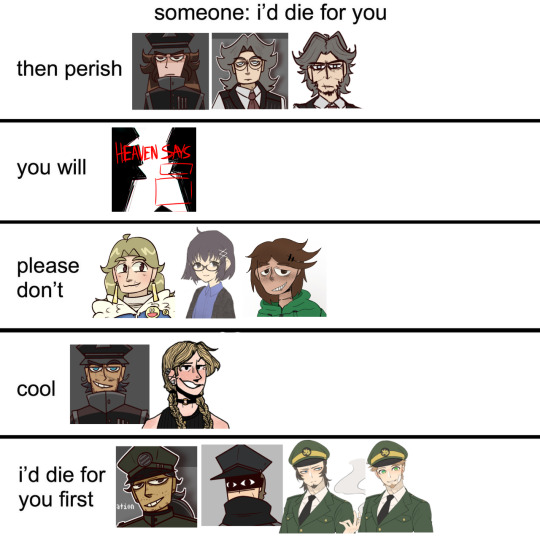




bam, these guys
i dont have any proper ref/art for boris, siv, natalie, katyusha and the highest order yet, also yalena and mavos' are outdated ish lol i need to do that and update a lot of these guys </3
#not art#shitpost#alignment chart#oc#original character#askali korslavika#behelmus gregori#vaklav yargoniv#iyovka solomakhin#boris solomakhin#matvey solomakhin#mavos korslavika#yalena ishutina#siv fadeev#natalie kubo#katyusha petrova#the spectator#the highest order
8 notes
·
View notes
Text


There is nothing particularly unusual about it: the Western fascination with Yugoslav modernist monuments, those strange concrete boulders scattered across the failed state, is renewed at regular intervals. Four years ago, for example, the Belgian photographer Jan Kempenaers published a photo monograph 'Spomeniks': 'Raised in peaceful fields, in the middle of nowhere', the respected Guardian introduced his book at the time, 'spomeniks look like places where alien spacecraft have landed or like album covers Pink Floyd.'' The filming of the new Netflix dystopian series 'The Tribes of Europa', which tells the story of the distant future of a continent divided - this will sound familiar - into numerous, small, mutually warring states, was completed on Petrova Gora these days. And so on, and so on, further and further away from what Yugoslav monuments used to mean: if there is something in common with all these advertising campaigns, dystopian TV-fantasies and photo-safaris around the places of the people's uprising, it is a complete lack of interest in historical, political and the artistic context from which the monuments grew. In the Western perspective, they are now only gigantic exotic souvenirs from a distant and incomprehensible past. Alien apparitions for which we do not know who exactly built them, when and why: rather traces of UFOs than signs of people's liberation war. Mark O'Neill's series of instagram photos, devoid of any information about the monuments other than the elementary mention of their locations, fits perfectly into such a tradition. So nothing new from the west. Perhaps that is why it is more interesting to check what is happening with the monuments today from the perspective of the East. Coincidentally, last week, just as the post-Yugoslav news portals were compulsively copying O'Neill's photo gallery, another anniversary of the demolition of the magnificent Monument to the Victory of the Revolution of the People of Slavonia by Vojin Bakić, which was erected in Kamenska near Požega, on February 21, 1992, passed almost unnoticed. Members of the 123rd Brigade of the Croatian Army in a well-organized mine action expertly removed them from the face of the earth. Only the small portal Antifašistički Vjesnik reminded of the sad anniversary by publishing a photo gallery of the ruins, along with a brief overview of the then propaganda lies from the local media about how the monument was broken by the Chetniks or, possibly, by a strong wind. But the ruin of Bakić's monument are not very photogenic, there are no spotlights or Instagram filters, it cannot serve as an advertising scenography, so the article from Antifašistički Vjesnik was not shared by anyone. No one to press copy, no one to click and paste: the anniversary of the destruction of one of the most beautiful monuments of the former Yugoslavia did not become news this year either. There is simply no room for some stories in the colorful, colorful, clickable memory of the media, just as there was none twenty-eight years ago. After all, what do you want: it was a war, we clicked cut.
Boris Postnikov, 2020
40 notes
·
View notes
Text

A New Species of the Genus Darevskia Arribas, 1999 from South Ossetia (Reptilia: Sauria: Lacertidae)
Boris S. Tuniyev, T. V. Petrova, K. Yu. Lotiev
Abstract
A new species of rock lizards of the genus Darevskia Arribas, 1999 — Darevskia arribasi sp. nov. is described from vicinity of Ertso Lake in South Ossetia. ... The coloration of adult males is olive-lettuce, or olive-brown from above; adult females are grey-brown; juvenile coloration coffee-brown with the blue and black spots on the edge of the outer ventral shields at the middle of trunk. Taxonomical status of new species is well supported with result of analysis of the mitochondrial cytochrome b data.
Read the paper here:
A New Species of the Genus Darevskia Arribas, 1999 from South Ossetia (Reptilia: Sauria: Lacertidae) | Tuniyev | Russian Journal of Herpetology (folium.ru)
18 notes
·
View notes
Text
Roadside Picnic 2017 Bulgarian edition - “Translator’s note” by Milan Asadurov.
Original title: “Бележка на преводача” Translated by: yours truly
The first Bulgarian translation of “Roadside Picnic”, created in 1982, was, naturally, based on the butchered 1980 edition from the Moscow-based publisher “Molodaya Gvardiya”*. At that time, when Bulgaria was the most loyal satellite of the Soviet Union, there simply couldn’t be any other official edition. When I wrote to Arkady Natanovich in 1981, asking him to clarify the nature of some of the Zone’s artefacts so I may better translate their jargonistic names into Bulgarian, his polite and laconic answer amounted to: “Boy, instead of fixating on the details so much, quickly get the translation to print before they stop it!” The authors were excited because this was the first time the book was published abroad.
Apropos, we tried to do the same with "Tale of the Troika" six years later. After a long struggle, I managed to dig up a xerocopy of a few issues of the Siberian magazine "Angara". That's where the "scandalous" sequel to "Monday Begins on Saturday" was published, a decision which parted the magazine’s head editor from his post. I translated "Tale..." with great pleasure, but even though the perestroika had already started, the Plovdiv-based publisher "Hristo G. Danov" couldn't reach an agreement with VUOAP** about the release of this government-sanctioned novel. (It took all the way till 1993 before it was published here.)
When the publishing house "Ciela" proposed to re-release "Roadside Picnic", I read the old translation which my Plovdivian colleagues had published three times by 1989 (!) and happily determined that it hadn't aged at all. (In no small part thanks to my editor at the time, Zdravka Petrova!)
Of course, I immediately began purging it of any meddling from the editors of "Molodaya Gvardiya". I removed unwanted additions, restored cut down passages, made it so stalkers can once again swear, drink and sleep with girls. In other words, I tried my best to recreate, in Bulgarian, the version of “...Picnic” specially prepared by Boris Natanovich for the 2003 release of their collected works. The plot remains the same; editorial interference had left it almost undamaged. Except now, readers can see the novel in its full glory and understand why Andrei Tarkovsky fell in love with it, and wanted to recreate it in his genius film “Stalker”, differently, through a different language - the language of cinema.
Milan Adasurov
Varna, September 2017.
*Молодая гвардия; Russian for “Young Guard”. In 1980, they published “Неназначенные встречи: Научно-фантастические повести“ (”Unintended meetings: Science-fiction stories”), an anthology containing “Roadside Picnic”, “Dead Mountaineer’s Hotel” and “Space Mowgli”. This was the first time Roadside Picnic had been released as a full story, rather than serialised in magazines.
**ВУОАП – Всесоюзное управление по охране авторских прав. Translates to “All-Union Administration for the Protection of Copyrights“. There’s no English acronym.
Source:
Strugatsky, A & B. (2017). Пикник край пътя (M. Asadurov, Trans.) Сиела. (Original work published 1972). ISBN: 9789542824442
https://www.ciela.com/piknik-kray-patya.html
#Roadside Picnic#Tale of the Troika#Translation#My translation#Bulgarian translation#Milan Asadurov#Милан Асадуров#Strugatsky brothers#Boris Strugatsky#I know I messed up the APA citation format. Leave me alone.
3 notes
·
View notes
Video
vimeo
Porter Robinson - Cheerleader from Hugh Mulhern on Vimeo.
PRODUCTION Production Company: Riff Raff Director: Hugh Mulhern EP/Producer: Precious Mahaga EP: Natalie Arnett Director's Representation: Hands Executive Producer: Porter Robinson Executive Producer: Slush Management (Aaron Greene, Neal O'Connor, Amar Pathak, Samuel Luria, Valerie Maybaum, Ryan Glatt) Creative Director: Pablo Jones Soler
BTS/DIGITAL Paul Mauer
SERVICE COMPANY Solent Film MD: Alex Momchev Solent Film MP: Magdalena Staneva Solent Film Service Producer: Tihomira Temelkova Assistant Producer: Elena Doroshenko Production Manager: Mitko Milushev Production Coordinator: Teodora Naydenova Production Assistants: Eva Taneva, Simona Atanasova, Serafima Deyanova, Dimitar Borisov
CASTING DIRECTOR Veselina Georgieva
AD'S 1st AD: Antony Tanev 2nd AD: Margarita Aneva 3rd AD: Damyan Tanev
CAMERA DOP: Nikita Popkov 1st AC: Vladislav Mateev 2nd AC A camera: Ivaylo Yovchev 2nd AC B camera: Luciano Ivanov Video Control: Borislav Stoyanov Drone Operator: Nikolay Georgiev - Tanera Data Manager: Delyan Kaloyanov
LIGHTING Gaffer: Alexander Trenev Electricians: Vasil Vasilev, Georgi Tsanev, Dimitar Yanev, Boris Vasilev Dimmer Board Operator: Philip Georgiev
GRIP Key Grip: Tsvetan Kostov Grips: Albert Nikolinski, Dimitar Dimitrov, Yulian Gotchev, Mihail Gotsov, Emil Ivelinov Head Technician: Borislav Tanev Crane Technician: Stanimir Vatsov
SOUND Playback: Kostadin Separevski
ART Production Designer: Elena Isolini Production Designer Assistant: Theresa Bates Art Directors: Momchil Tasev, Aleksandar Yanev Construction Manager: Minko Krustev Props Master: Ada Paunova On-Set Dressers: Nedelcho Hazarbasanov, Yavor Milanov Set Dressers: Kostadin Dervenski, Evtim Evtimov
LOCATION Location Manager: Anita Miletieva Assistants: Elena Karadusheva, Lidiya Aleksandrova
STUNTS Stunt Coordinator: Ivan Vodenicharov Stunt Dept. Coordinator: Aneta Ivanova Stunts: Marina Yordanova, Desislava Slavova, Tea Markova, Mariela Kostadinova, Ventsislav Hristov
CHOREOGRAPHY Kosta Karakashyan
SFX Supervisor: Nikolay Fartunkov Senior Technician: Ivan Kazakov Technicians: Vladimir Mitov, Blagoslav Zhenkov
HAIR/MAKE-UP Hair Cut & Color: Miyuki Goto Artist's Hair & Make-up Artist: Yesol Choi Artist's Hair & Make-up Artist Assistant: Gohun Kim Head of Make Up: Gergana Batanova Head of Hair: Veselka Tsekina Hair Stylists: Bilyana Borisova, Gergana Ivanova, Nataliya Kamenova, Gratziela Dimitrova
COSTUME Artist's Stylist: Luca Wowczyna Luca's Assistant: Elliott Lane Assistant Stylists: Maria Petrova, Teodora Marinova, Nadya Dobrikova, Yoana Kusheva, Emiliyan Bonev Tailor: Marieta Duncheva Mask Design: Audrey Mai
ORGANIZATION Set Manager: Georgi Asenov PAs: Lyubomir Tabakov, Ivaylo Tabakov, Vulcho Monkov
STOP MOTION: THE JUNKS Stop Motion Supervisor: Zlatin Radev Animator: Boris Wolf Assistant Animator / Puppet Doctor: Diliana Valcheva Rigger / Assistant Animator: Teodor Ralev Set Dressers: Alex Suninski, Marin Nalbantov
EDITING: TRIM EDITING Editor: Joseph Taylor Edit Assistant: Anders Mills Producer: Noreen Khan
POST PRODUCTION VFX Supervisor: Vasil Galabov VFX: The Mill EP: Saskia Delius Producer: Sam Ashby 2D Lead: Ben Gallagher 2D Assists: Henry Claud N’guetta, Jane Williams, Muhaddissa Hasham Associate Producer: Rushikesh Shelar Production Coordinator: Karishma Verma Compositor Supervisor: Nanda P V Compositor Lead: Ragesh Ramachandran Rotoscoping Supervisor: Kunal Bendke Prep Lead: Jalander Madishetty GABHA Studios: Dafydd Upsdell, Daniel Morris Grade: Andrew Francis Add’l Post Production: Andrzej, Nina Muro, Nick Lane CGI: Alex (chippy) Futtersak, Dom Harwood VFX Artists: David Ochoa
TRANSPORT Coordinator: Vladimir Mashinata Blagoev Prod Vans: Svetoslav Yordanov, Ivo Radkov, Iliya Iliev, Georgi Evstatiev
CATERING Cherry Craft & Catering Manager: Mariela Manolova Cherry Craft & Catering: Petya Kovacheva, Ivan Nalbatski, Borislav Parvanov
SUNWEAVER CREATIVE Shawn Chapman: Producer - Creative Jacqueline Adorni: Producer Garrett Robles: 3D / Previs Lauren Sperling: Project Coordinator Matthew Hunt: Production Assistant
WARDROBE / COSTUME: VENIA Christine Ko: Key Costumer Keeter Ly: Key Costumer
WARDROBE / COSTUME: SUNWEAVER Cybal Hall: Costume Supervisor Annabelle Gerke: Key Costumer Christopher Hall: Costumer (Silkscreening) Daniel Rose: Lead Wig Designer Kieran Smith: Wig Stylist Samantha Michael: Wig Stylist
ART DEPARTMENT Kigarumi Sensei Taiki Nishikawa: Key Artist Paul Nishikawa: Artist
Creative Character Engineering Andrew Clement: Lead Artist Lesley Becerra: Head of Production Brad Palmer: Sr. Project Manager Cory Fisher: 3D print/fabrication Alex Dill: Fabrication Mike Ross: Fabrication
Special Thanks - Venia
0 notes
Text
Family
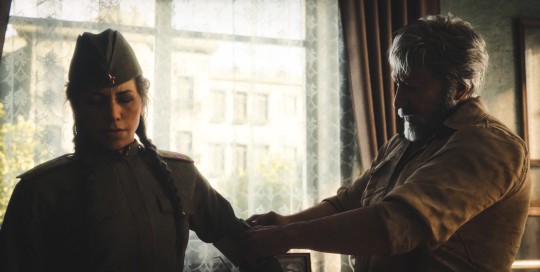
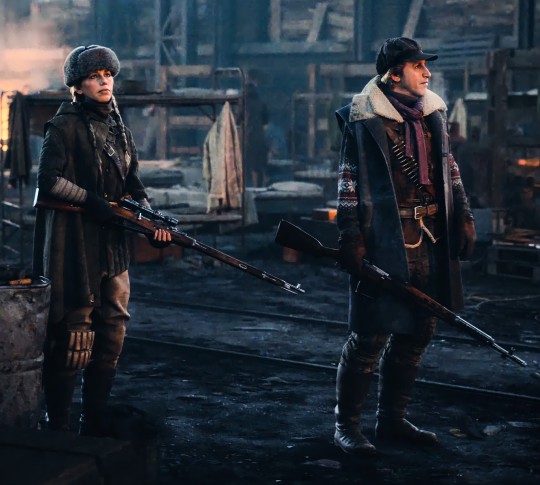
94 notes
·
View notes
Text
I thought I wouldn't like any of Vanguard's characters, but here I am crying over The Petrov's.
#call of duty#call of duty vanguard#polina petrova#GOD#shes such a girlboss#I got too attached to Boris and Misha#I miss them already
14 notes
·
View notes
Photo

Svetlana Petrova
Boris Kustodiev's "Merchant’s Wife at Cat’s Tea"
34 notes
·
View notes
Text
Dignity Of Memory
After almost 30 years since the break-up of Yugoslavia, we can take a stroll through a part of the architectural history with the benefit of distance.
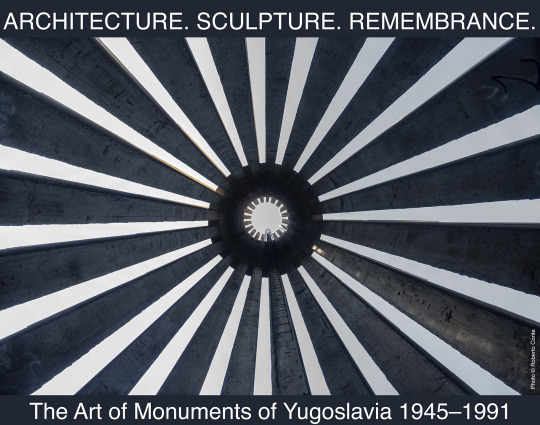
The heritage of Yugoslav architecture was taken on almost a decade ago by Croatian Architects Association in collaboration with Maribor Art Gallery with the regionally conceived project Unfinished Modernisations – Between Utopia and Pragmatism – Architecture and Urban Planning in the Former Yugoslavia and the Successor States, and last year with the global exhibition in New York City's MoMA Toward a Concrete Utopia: Architecture in Yugoslavia, 1948–1980.
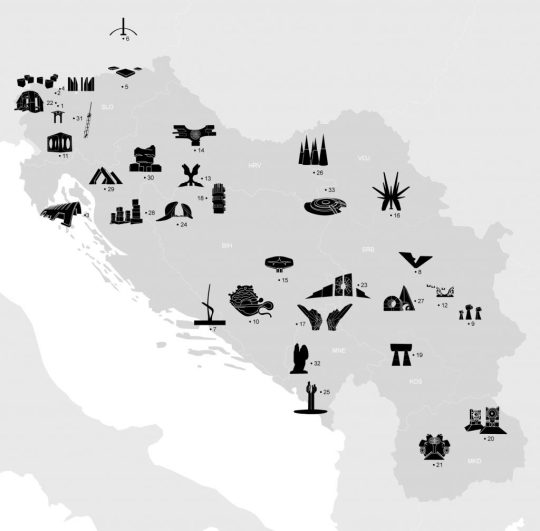
In the architecture and art of ex-Yugoslavia, the monuments to the victims of the People's Liberation War stand out. Through their artistic language, they remind us of the dignity of human life and death. They are powerful markers of the once-common state's public open space. Their unique architectural and artistic design has placed them on a field of timelessness, which is not constrained by geographic and cultural borders, age, race, or political views.
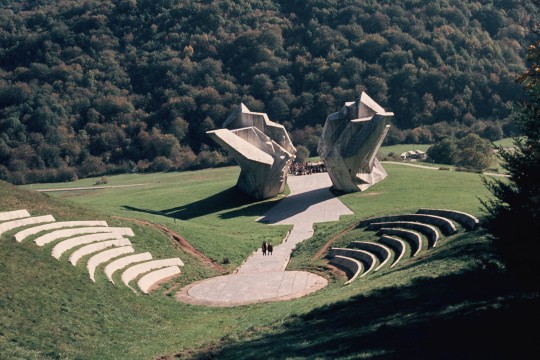
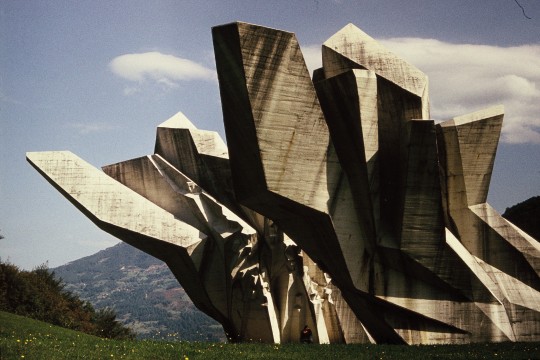
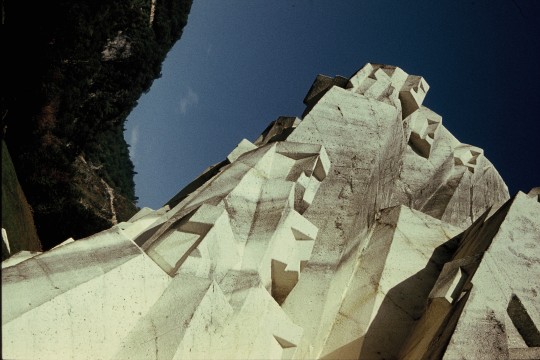
Memorial complex to the Battle of Sutjeska is an exceptional work by Miodrag Živković and one of the best sculptural memorials in the Yugoslav space. | Photo from the archive of Miodrag Živković
Monuments were built and designed by Yugoslav architects and sculptors of the highest profile, such as Bogdan Bogdanović, Edvard Ravnikar, Miodrag Živković, Dušan Džamonja and many others. Instead of the regime's symbolism, their creations combined the present, the past, the elements of antique necropolises, ethnography and spatial poetics.
youtube
Last and First Men by Johann Johannsson (2020) narrated by Tilda Swinton
The monuments are predominantly designed as sculptural-architectural structures, abstract architectural sculptures. Many were constructed in concrete, which was elevated to the status of noble material by virtue of shaping and finishing. They are sited in authentic spatial situations and historical settings, designed as a commemorative path. Every monument tells a story connected with the events and victims.
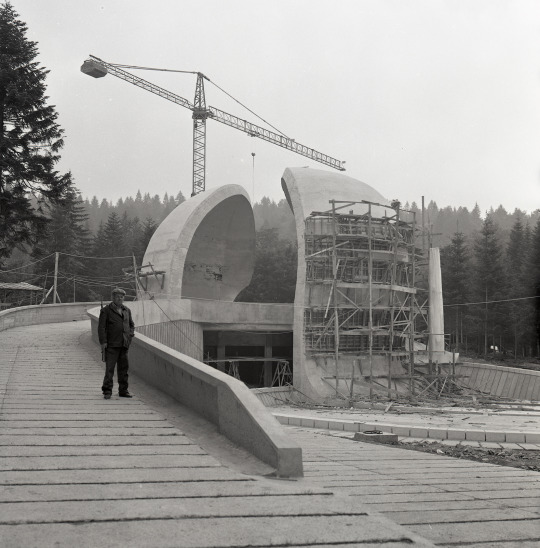
Memorial complex Korčanica is dedicated to the largest Partisan hospital, which was active in the liberated territory of the slopes of Grmeč between 1942 and 1943. | Photo from the archive of Miodrag Živković
In mid-march 2019, Gallery DESSA, ab-Architect's Bulletin magazine and Architectuul began the preparations for the exhibition and publication named Architecture. Sculpture. Remembrance.; The Art of Monuments of Yugoslavia 1945–1991. On the basis of high architectural and artistic value of the structures and the exceptional contemplative qualities of the spatial designs, the curators selected 33 monuments and memorial complexes from all the republics and autonomous provinces of ex-Yugoslavia. The exhibition was prepared in collaboration with authors, photographers, institutions from the ex-Yugoslav region, which has also laid the foundation for future co-operation. The exhibition will present and evaluate the exceptional architecture of the Yugoslav monuments, whose aesthetic and structural innovation is enhanced by their idiosyncratic artistic expression.
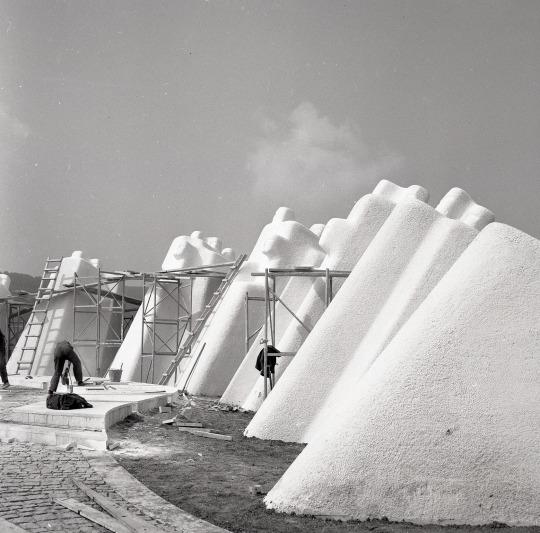
The memorial complex Kadinjača by is dedicated to the Partisan fighters of Workers' Battalion of Užice. | Photo from the archive of Miodrag Živković

Monument to the Revolution by Dušan Džamonja is located at the highest peaks of Kozara mountain. | Photo from the archive of Miodrag Živković
Monuments are also political art, they are an uncompromising tribute to humanity, to reverence towards the victims, conveyed by means of the authors' individual artistic expression. With the dissolution of Yugoslavia into individual independent states in 1991, it seems that the need for respecting the remembrance expressed by its memorials is waning. As a result, the present state of repair of the monuments and their treatment varies depending on the region. In some places, the past and the strivings of the previous generations are held in respectful memory while elsewhere, the monuments have been abandoned, left to ruin, or even desecrated.
youtube
“Beck’s Legendary - Croatia Infiltration” is a beer commercial, which exploits the Monument of Petrova Gora.
Due to their abstract nature, they may be used for very different purposes, such as shooting TV advertisements and music videos, or as fashion runways. Such use of monuments by individuals who have no appreciation or knowledge of the past and therefore cannot respect it represents misuse as well as contempt for the dignity of the victims and their memory.
youtube
The exhibition is planned to be shown in all the former Yugoslav republics. We wish to foster a sober and respectful assessment of the value of ex-Yugoslav monuments and draw attention to their cultural and contemplative significance, and thus lend support to the maintenance and preservation of the memorial areas. It will present the exceptional, progressive, and still-contemporary creative language of their artists and other creators, which transcends the superficiality of the quest for the different, the exotic, the picturesque, and the unknown. Monuments are ties to the past, they reminiscent of the dignity of human life and death. And remembrance.
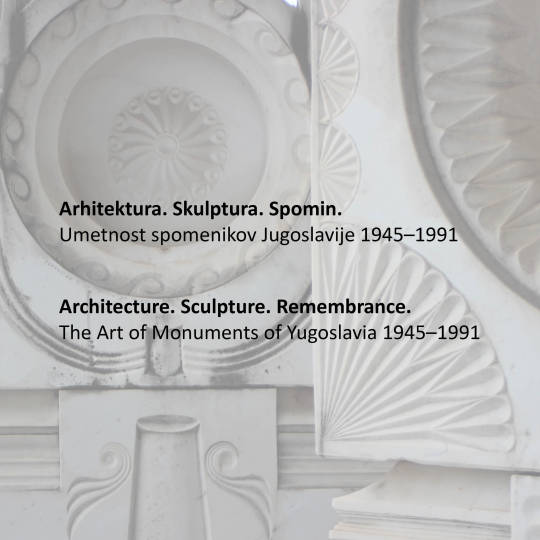
The exhibition started to travel to different cities of the territory of Ex-Yugoslavia. Because of COVID-19 restrictions the project continues online. The next stop is co-hosted by the creative community Avtomatik Delovišče under the auspices of the Municipality of Koper. Together with Architectuul 33 monuments will be presented daily with a conclusion online webinar on 29. November 2020.
---
Architecture. Sculpture. Memory. The art of monuments of Yugoslavia 1945–1991 online webinar 29 November 2020
Dessa, AB, Avtomatik Delovišče Curators Boštjan Bugarič, Kristina Dešman, Maja Ivanič, Špela Kuhar, Eva Mavsar, Špela Nardoni Kovač, Damjana Zaviršek Hudnik Media partner Architectuul
*********** Program
10:00 Introduction Christian Burkhard, editor in Chief Architectuul, Berlin Boštjan Bugarič, senior editor Architectuul, Berlin Mara Ivanič, Dessa Gallery, Ljubljana
youtube
10:20 Spaces and Dignity Sanja Horvatinčić, Institute of Art History, Croatia Vladimir Deskov, School of architecture and design - UACS, N. Macedonia Ana Ivanovska, Faculty of Architecture Skopje, North Macedonia Kristina Dešman, Maja Ivanič, Špela Kuhar, Eva Mavsar, Špela Nardoni Kovač, Damjana Zaviršek Hudnik, DESSA Gallery, Slovenia Jelica Jovanović, Grupa arhitekata / Docomomo Serbia Boris Trapara, Bosnia and Herzegovina Bekim Ramku, Docomomo Kosovo Slavica Vučković, Faculty of Architecture Podgorica, Montenegro Moderator: Boštjan Bugarič
11:00 Yugoslavia Express Roberto Conte presenting the field photo trip
11:30 Presentation and Dignity Roberto Conte, Italy Relja Ivanić, Serbia Matija Kralj, Croatia Elena Chemerska, North Macedonia Donald Niebyl, Spomenik Database USA Andrew Lawler, Spomenici NOB, Serbia Moderator: Kristina Dešman
12:00 Embodied Experiences: Investigating the relation between architecture, landscape and symbolism in WW2 monuments of socialist Yugoslavia; a master thesis by Vida Rucli, Faculty of Architecture in Ljubljana, menthors Maruša Zorec and Luka Skansi
12:30 Culture Routes in Montenegro Slavica Vučković presenting the project
13:00 (In)appropriate Monuments: Interview with Miodrag Živković In loving memory of Miodrag Živković by Jelica Jovanović
youtube
62 notes
·
View notes
Text
Elias Petrova’s Presidency

2004: Elias is Boris's son, who followed in his footsteps becomes vice-president. Educated in both Soviet and American institutions, Elias was known for his strategic mind and political acumen. As President, he continued his father's legacy of centralization and state control, accelerating both.
Elias Petrova’s presidency built upon his father’s legacy by advancing the nation’s socialist framework while introducing his own reforms to address new challenges and opportunities. His administration was characterized by a focus on environmental sustainability, technological advancement, and international cooperation. Elias navigated complex geopolitical landscapes, responded effectively to natural disasters, and promoted cultural and educational reforms that reflected both socialist values and modern American identity. His leadership ensured the continued prominence and stability of the Soviet States of America on the global stage.
2009: Rising tensions with China over trade and territorial disputes lead to a brief military standoff. Elias’s diplomatic skills prevent escalation, resulting in the "Pacific Peace Accord" which fosters cooperation in the Asia-Pacific region.
2010: Elias signs the "Pan-American Socialist Defense Treaty" strengthening military and economic ties with Latin American socialist countries, ensuring mutual defense and cooperation.

2011: A severe tornado outbreak in the Midwest causes widespread destruction. Elias oversees the implementation of advanced early warning systems and improved infrastructure resilience programs.
That same year, Elias expands the "Unified Education System" to include vocational training and higher education programs focused on science, technology, engineering, and mathematics (STEM), aligning the workforce with the nation’s technological and economic goals.
2012: Elias Petrova's policies lead to economic growth but at the cost of individual freedoms. The Petrova family cements its control over the political landscape through a combination of popular support and political manipulation.
Deployment of peacekeeping forces in the Middle East to stabilize the region and protect socialist-aligned governments from insurgencies. This move underscores Elias’ commitment to supporting global socialism and maintaining international stability.
2015: Establishment of the "Global Health Alliance" with several nations to address global health issues, such as manageable diseases and access to healthcare. This initiative emphasizes collaboration in medical research, vaccine development, and healthcare infrastructure.
2016: The discovery of vast untapped oil and natural gas reserves in the Arctic region around Alaska sparks intense international interest. With global energy demands rising, Canada lays competing claims over parts of the Arctic seabed, citing international maritime boundaries and historic exploration rights.Elias orders the deployment of the USSA’s Northern Fleet to secure the Alaskan coastline and assert control over the disputed waters. A standoff ensues between SSA and Russian naval forces.
2017: Facing the prospect of a prolonged and potentially devastating effects of the “Alaska Conflict”, international pressure mounts for a ceasefire. The United Nations intervenes, and a temporary truce is brokered.
2019: Elias Petrova announces his surprise retirement after his term is over. It would later be revealed to the public that Elias had become terminally ill, resulting in his death in 2022. His niece Elena Petrova, a young, charismatic woman is groomed to take over. The election is carefully orchestrated to ensure her victory in the coming year.
#Elias history#Elias#Elias Petrova#Alternate history#Soviet America#fictional worldbuilding#dystopian future#Cold War victory#totalitarian regime#authoritarian government#political fiction#alternate universe#Soviet aesthetic#fictional superpower#creative storytelling#fictional nation-building#political worldbuilding#alternate USA history#fantasy politics#alternate political systems#Soviet influence#creative dystopia
1 note
·
View note
Text
more soft facts: sweet vanilla Valeri-flavor
Valeri Kharlamov loved to bake. His sister's favorite was when he made meringues, but his favorite thing to make was blini. However, he loved eating blini even more, so if Boris Mikhailov happened to call while he was cooking and casually mention that his wife Tanya already had a batch of blini on the stove, Valeri would drop everything and run to eat with them
Valeri was extremely protective of his large rookie Alexei Kasatonov. When he realized Kasatonov had no family in Moscow and so was staying in the dorms even on days off, he arranged a rookie-custody agreement with fellow veteran Gennady Tsygankov, insisting that Kasatonov sleep over with each of them on alternating nights
when an NHL exec slipped him some cash, he spent it on three pairs of knee-high white leather platform boots which he gave to Tatiana Mikhailov, Vera Petrova, and his sister Tanka. When Tanka later slipped and tore a hole in her beautiful boot and cried about it, he looked at it and agreed that wouldn't do and promised to find a replacement. He and Tanka loved dress up and he "dressed her like a doll"
he, Tanka, and Alexander Maltsev also loved having hair parties, and made best friends with a hairdresser named Sashka who practiced giving them perms
Valeri designed festive wall calendars and painted posters which he hung around the national team training compound every year to brighten the place up
when Valeri was in the hospital after breaking his leg, Mikhailov and several other teammates made a schedule to drive his mother to see him. She had insisted that she could take the train (a 50 minute ride), so Boris just parked at the train station by her house waiting for her to get there. When they arrived they realized she wouldn't be allowed into the military hospital except at strict times, so Mikhailov and the others went around back and broke a lock off the back gate for her. Valeri himself was very distressed that he was in the hospital so long his hair grew out of its feathery perfection, so his sister and his friends snuck Sashka in to give the whole hospital wing fresh haircuts
soft facts that sound like I ate a prompt generator, part 1
noted Soviet goon Boris Mikhailov plays the balalaika
Vladimir Petrov's parents' cottage was only in the next village from the Soviet training compound, so every fall he would bring in big baskets of fresh apples to share with everybody
when Boney M went on tour to Moscow in 1978, Petrov asked for and received permission to take the night off and made his teammates go with him. He said it was the best concert of his life
members of the Soviet team were known for trying to bring as much as they could back from international trips. One time, custom officials opened their gear bags and out spilled clouds of white fluff, rolling across the airport floor. The players had to explain that their wives were knitters, and they were doing their husbandly duty of raiding the local yarn stores for mohair
45 notes
·
View notes
Text


39/100 - Album art for fake band “Better Than Boris”
“The feud between Taylor and Kanye may be more legendary, but the feud between Moscow musicians Ivan Turgenev and Boris Popov is way more fun. After the two first fell out publicly in 2018 at the city’s famous annual Afisha Picnic music festival, Turgenev promptly launched a band called ‘Better Than Boris.’ Not to be outdone, Popov is now fronting a group called ‘Ivan the As*hole’. It’s not even clear what prompted the feud. Some say it was over a look that Popov was supposed to have given Nadia Petrova, Turgenev’s then-girlfriend; some claim it was over a vatrushka — a kind of Russian danish pastry — that Popov may or may not have jostled out of Turgenev’s grip and onto the street. I give you this background only so you can appreciate why most of the track titles on Better Than Boris’s latest album involve the phrase ‘Boris is a …’ and then some choice Russian insult. Don’t be fooled by the artsy cover design — this album is a brutal takedown of Popov, his friends and family, and even Kamchatka, Popov’s favorite bar. And Turgenev really delivers, belting his offensive lyrics describing all the unnatural acts of his arch-rival with fierce focus. If you understand Russian, you may find your eyes watering. If you don’t, just enjoy an angry young man at the height of his yelling powers, and the few English lyrics that make about as much sense as the feud that sparked them.”
— Arkady Preobrazhensky, The Moscow Times
#album art#100DayProject#100daychallenge#COVID19#graphic design#love#portland#design#music#100daysofbandnames
0 notes
Text
Red Alert (MWoB P4)
Despite everything that had happened, Susie couldn't help but feel sorry for the trembling woman seated on the couch. True, Allison had replaced her as Alice Angel's voice actress, but it didn't take a professional to see how traumatized she was. "Believe me, I am sorry about what I did," Allison said quietly. Though her face was no longer deformed, her skin remained chalk-white, a lingering side effect of Joey attempts to turn her into 'the real' Alice Angel. Naturally, she had ditched the little black dress, and now wore a simple white nightgown and a red bathrobe. "Joey really wreaked havoc on you, didn't he?" Allison nodded. "He couldn't bribe me a second time, so he found another way of silencing me. And as you know, that went badly for me..." (BATIM) "Who was that?" Henry asked the moment they were out of earshot. "I know that wasn't you, Alice." "After we turned against Joey, he started looking for...replacements," the angel explained. "He started doing things to former workers. Horrible things. One of them was the woman who replaced Susie--what was her name?" "You mean Allison," Henry realized. "That's her." Alice snapped her fingers. "From what I overheard, she wasn't Joey's first choice, but Susie's not here." "Maybe Susie wouldn't be so scary-looking," Boris commented. "Her face looks all wrong. And she's kinda crazy too--she keeps saying she has to be perfect." He frowned. "Sometimes, she speaks in this weird language." (BATIM) "It wasn't just about my appearance, though." Allison's voice snapped Henry out of his flashback. "I remembered things--things I wanted to forget." "Can't say I'm surprised," Natasha said, appearing in the doorway. "Hello, Sasha." A brief look of surprise crossed Allison's face. "Natalia." "You know her?" Scott asked in surprise. "She's one of the few people to have escaped the Red Room's clutches," Natasha explained. "I knew her as Alexandra Petrova." "I changed my name after defecting to the West," Allison added. "And I've come to prefer it. My old name has too many bad memories associated with it." Henry placed a finger to his chin in thought. "If half the things I heard about the Red Room are true, that would explain your behavior back in the studio." "Yeah, that has PTSD written all over it," agreed Fury. "Lucky for her, I know someone who can help with that." Susie nodded. "Clearly, she's going to need a lot of therapy, and a lot of support." She walked over and sat down next to Allison, putting an arm around the other woman's shoulder. "And she'll get that in spades."
0 notes
Video
vimeo
Written and directed by Lado Kvataniya Director of photography | Andrey Krauzov Producer | Alexander Medvedko Executive Producers | Ilya Stewart Murad Osmann Starring | Oxxxymiron | Markul | Vlada Cox | Jan Daniel | Boris Gusakov | Vyaсheslav Yrovskiy | Artemiy Myakishev | Julia Kivi | Nadin Ksenia | Beryoza Annet | Karina Julia | Ryabova Polina | Svetlova Christina | May Alexandra | Avramenko Amori | Salvatore Alisa | Liss Selena Verner Editor | Vlad Yakunin DOP 2 unit | Denis Firstov Special Thanks | Alex Mikeladze Art Director | Dmitry Onishenko Set Designer | Denis Nikolaenko Assistant Art director | Ekaterina Kuznetsova Props Master | Alexander Lebedev Casting | Margo Sayapina Special effects | Peter Gorshenin Make Up Artists | Olga Mikhailova Evgeniy Mikhailov Costume designer | Anna Kudevich Boris Kukolkin 1st A.D. | Olga Mitina Unit Production Manager | Dmitry Dimchevskiy Production Manager | Misha Goglov Location Manager | Vladimir Kravchenko Assistant Location manager | Alexander Pisarev Colorgrading | Artem Leonov Sound design | 4 33.studio Visual Effects | Carbon Core Art Director | Ilia Rutkovskii CG Supervisor | Denis KHaritonov CG Coordinator | Daria Petrova Concept Artist | Sergei Vasnev Rotoscoping and clean-up | Elena Pestrikova | Stepan Masychev | Viacheslav Cherepanov Post Production | Epic Special Thanks | Elena Gracheva | Plussize.moscow agency | Oxana Solodka, Vitaminka | Film agency Igor Gavar | Oldushka Models Agency Hype Production | 2017
0 notes
Video
vimeo
ORPHEUS Making Of from CARBON CORE on Vimeo.
Making of Tim Aminov feat. Cédric Gasaïda /// ORPHEUS Original Video: vimeo.com/261789043
Vfx Art Director | Ilia Rutkovskii CG Supervisor | Denis Kharitonov CG Coordinator | Daria Petrova Water FX | Roman Chevozerov Particle FX | Eugene Kolesnikov 3D Artist | Aleksandr Chukov VFX | CARBONE CORE | carboncore.ru
///Synopsis/// In a world devoid of verbal communication, every man, woman and child emits a constant, unique sound. Those whose sound possesses healing qualities are called Orpheuses. They are hunted down, stripped of their abilities and killed. This is the story of the last living Orpheus.
Written and Directed | Lado Kvataniya Director of Photography | Andrei Maica Producers | Ilya Stewart, Murad Osmann, Alexander Medvedko, Margo Sayapina
Co-Producers | Lado Kvataniya, Tim Aminov, Andrei Maica Production managers | Dmitry Dimchevskiy, Julia Samoylova, Mikhail Goglov Producers Assistants | Ira Ragozina
First Assistant Director | Alexander Eidman
Production Designers | Margarita Ablaeva, Anna Dominina Costume Designers | Anna Kudevich, Boris Kukolkin
Location Managers | Vladimir Kravchenko, Denis Iordanov/AcePlace
Choreography | Irina Glushko
Make-Up artist | Igor Boyko Camera Assistant | Roman Markin Gaffer | Viktor Ronzhin Montage | Anton Mironenkov | antonmironenkov.com Clean Up | Alexander Kurbanov Font | Andrey Olshevskiy
Hype Production | RUSSIA / 2018
0 notes